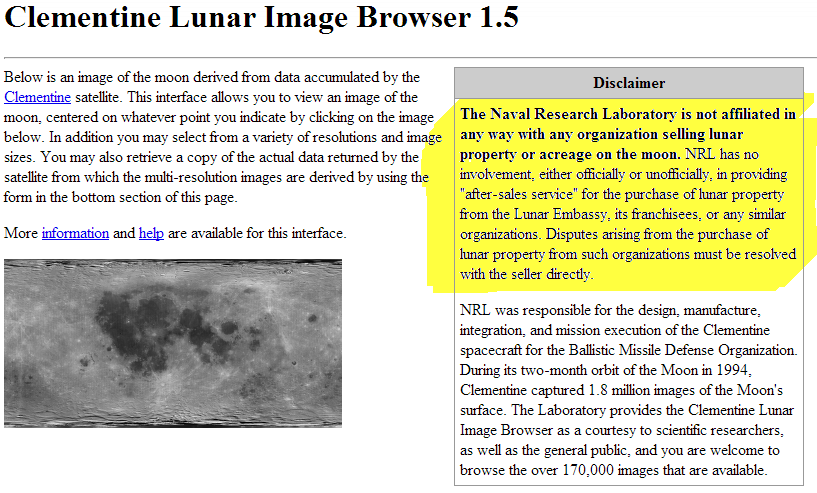
 |
|
Moon
~ Lunar Mining Possibilities
Clementine (funded by the Department of Defense)
After Apollo, the Moon was not specifically
revisited for 22 years, until an unmanned spacecraft,
Clementine (funded by the Department of Defense),
orbited it to conduct mapping studies between February
19 and April 21, 1994, using UV/Visible, Near IR, and
High Resolution Cameras, Lidar (a radar altimeter),
and a radar-like unit that transmits in the S-band
radio frequency (2.293 GHz, or 13.19 cm wavelength). |
||
|
Water Deposits Clementine Makes Controversial Discovery Clementine made a controversial discovery, which, if proved correct, has major implications for humans returning to the Moon. Its S-band radio unit detected abnormal reflections from the rim of a huge crater (basin) around the lunar South Pole, in areas permanently sheltered from the Sun's rays... Clementine image of the South polar region, where a large crater lies within the Aitken Basin. Traverses (in green) using a radio signal detected a lower reflectivity zone that may indicate water ice. The red areas are parts of the crater in permanent shadow, which would favor preservation of the ice. These reflections could be due either to water ice or to some abnormal surface roughness condition. If indeed ice is present in significant quantity, then this precious material (which supplies water needed for life and also oxygen, when broken down by electrolysis) might allow us to establish a manned base on the Moon. Transport of sufficient water and oxygen for long stays is presently beyond our technical capability. - SOURCE - NASA Follow up Mission - The Lunar Prospector Spacecraft
The Primary Mission The Impact Experiment The first results on Lunar Prospector's detection
of ice were released during an exciting press
conference, held on March 5, 1998. Around both poles,
the neutron spectrometer has indeed detected neutrons,
released from hydrogen by natural cosmic ray
bombardment of water ice in craters with sheltered
shadow zones. The drop in neutrons emanating from the
Moon is clearly maximal around the poles as seen in
this plot.
|
||
 U.S. Department of Defense U.S. Department of DefenseOffice of the Assistant Secretary of Defense (Public Affairs) News Transcript Presenter: Dr. Dwight Duston, Assistant Deputy for Technology, Ballistic Missile Defense Organization; December 04, 1996 1:45 PM EST Subject: Discovery of Ice on the Moon The water on the Moon reported by the Pentagon is presented as: Q: What's the presumptive volume of it then, and how did you discern that? A: As I mentioned, what we can tell from looking at the radar return is roughly the area that is covered by this. Assuming it reflects ice like ice on Mercury -- making that assumption. That's been well looked at. Then in order to see this back scatter effect, this roadside reflector effect; it's estimated that we have to see some number of wavelengths of our radar into the ice. In reviewing the paper, several of the reviewers posited we probably need to see somewhere between 50 and 100 wavelengths. So our wavelength is about six inches. So at the thickest case, it's roughly 50 feet. Q: That translates to what in volume? A: We were very conservative in the press release, but if you take basically 100 square kilometers by roughly 50 feet, you get a volume of something like a quarter of a cubic mile, I think it's on that order. It's a considerable amount, but it's not a huge glacier or anything like that. Q: Can you compare that with something you know? A: It's a lake. A small lake. Warning: .GOV and .MIL website links ahead Original Transcript Department of Defense December 04, 1996 The Clementine Satellite ~ Lawrence Livermore National Laboratory PDF File U.S. Naval Research Lab Clementine Mission: 1994 Image Gallery Version 2 |
||
As
a side note, but very relevant to our venture...
the old Version 1.5 Navy Clementine Browser had
THIS disclaimer on the front page (highlighted in
yellow) You can still view that link on the WAYBACK
MACHINE HERE So... Don't go bothering
the NAVY Space Fleet with claim jumper
disputes!!
|
||
|
Among specialized products were more detailed
maps of lunar topography (elevations) and global maps
of the distribution of several chemical elements, such
as iron (Fe) and titanium (Ti), determined by
analyzing reflectance variations at 0.75 m m and 0.95
m m, where these elements absorb irradiation. The Fe
map, reproduced below, indicates that, while iron is
widespread, its maximum concentrations are in a broad
region on the nearside, roughly coincident with the
vast lava outpourings into Oceanus Procellarum and
several other mare basins. SOURCE
-
NASA
|
||
|
Thorium Deposits Information on the distribution of radioactivity on
the lunar surface was one goal of Lunar Prospector. This
map shows that the element thorium is highest on the
front side of the Moon, mainly in the highlands south of
Mare Imbrium. The correspondence with the Imbrium Basin
suggests that the basaltic lavas that filled it were
enriched in Th. Note that corresponding highland
surfaces on the farside are lower. - SOURCE
-
NASA
Thorium is a chemical element in the periodic table that has the symbol Th and atomic number 90. As a naturally occurring, slightly radioactive metal, it has been considered as an alternative nuclear fuel to uranium. When pure, thorium is a silvery white metal that retains its lustre for several months. However, when it is contaminated with the oxide, thorium slowly tarnishes in air, becoming grey and eventually black. Thorium dioxide (ThO2), also called thoria, has one of the highest melting points of all oxides (3300°C). When heated in air, thorium metal turnings ignite and burn brilliantly with a white light. Thorium as a nuclear fuel Thorium, as well as uranium and plutonium, can be used as fuel in a nuclear reactor. Although not fissile itself, 232Th will absorb slow neutrons to produce uranium-233 (233U), which is fissile. Hence, like 238U, it is fertile. In one significant respect 233U is better than the other two fissile isotopes used for nuclear fuel, 235U and plutonium-239 (239Pu), because of its higher neutron yield per neutron absorbed. - Source - Wikipedia |
||
| Lunar Mining Possibilities
Page Two |
||
|
All material on these pages, unless otherwise noted, is © Pegasus Research Consortium 2001-2019 |
 Webpages © 2001-2019 Pegasus Research Consortium |